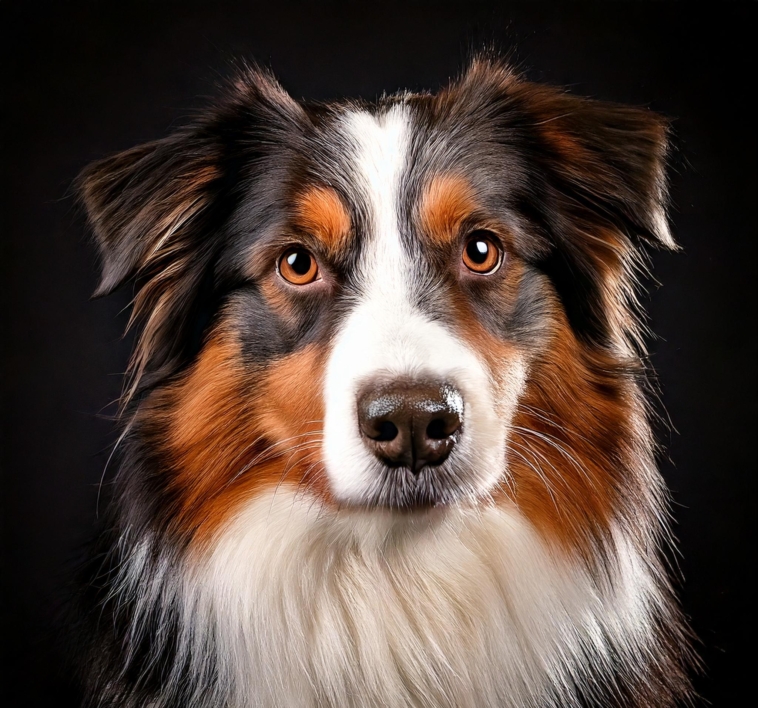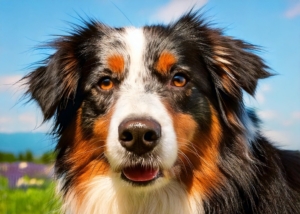The Quirky Tale of the Australian Shepherd
You’d think the Australian Shepherd hails from Australia, right? Wrong! These clever canines pulled a fast one. Despite the name, they actually have their roots in the American West—talk about a well-traveled identity crisis.
These canines aren’t pretty faces with their hip cool black, blue merle, red, or red merle fur—they’re essentially the athletes, geniuses, and faithful best buddies of the canine world. Males are 50–65 pounds of pure workhorse, and females at 40–55 pounds of squirm and smarts.
Word of advice: if you’re a couch potato, Aussies might just host an intervention. These pups need exercise like fish need water. Agility courses, obedience training, herding your kids—whatever keeps those brains and legs busy.
Home Sweet (Highly Stimulating) Home
An Australian Shepherd’s dream home isn’t a house—it’s an amusement park.
- Space to Zoom: If your yard is smaller than a doormat, you might need to rethink your situation. Aussies require acreage or regular excursions.
- Brain Olympics: Boredom is the devil they know. Pull out the treat puzzles and mental challenges.
- Sweat Sessions: Run, walk, chase invisible sheep—just keep ’em in motion.
- Nap Zones: Treat their daily marathons with the plushest beds and blankets available.
- Clean Freaks: Keep the living space spotless unless you enjoy dust bunnies and fur tumbleweeds.
- Dog-Proof Everything: Baby-proofing, but for a paws-itive genius furry creature.
Skip all this and be ready for a fur tornado, zoomies, and passive-aggressive glares.
Aussie Appetite: The Culinary Chronicles
Feeding an Aussie is not about slapping kibble in a bowl. You’re basically managing a canine nutritionist’s dream.
- Proteins: Build those mighty herder muscles. Chicken, beef, lamb—yes please.
- Fats: Think brain food, not belly fat. Fish oil is the elixir.
- Carbs: Energy, but make it whole grains and veggie-based.
- Vitamins & Minerals: Broccoli isn’t just for humans anymore.
Tips for feeding:
– Read the label as if it were the back of a gourmet food product.
– Don’t overfeed. Fat Aussies = grumpy hips.
– Plan meal times as a Michelin chef.
Foods to avoid:
Chocolate, grapes, onions, and garlic. (No Italian meals for them.)
And yes, your veterinarian is still in charge when it comes to dietary guidance.
Zoomies and Gains: The Exercise Files
These pups weren’t designed to Netflix and chill. Here’s their perfect exercise routine:
- Daily Walks: 60 minutes or risk being judged by those shiny eyes.
- Fetch Like You Mean It: Balls, frisbees, pinecones—it’s all game.
- Trick Training: Train them neat tricks like “roll over” or “clean the house.” OK maybe not that.
- Freedom Runs: Get them into a safe zone and let them go full Forrest Gump.
- Play Dates: Because every Aussie requires friends who also bark.
Skip their workouts and hello chewed shoes and thesperichabies.
Spa Day for the Aussie
If Aussies did Tinder, “great hair” would be included in the bio. But that hair isn’t kept up for free.
- Brushing: 2–3 times a week with proper tools unless you want to crochet a second dog.
- Ears: Inspect on a weekly basis unless you like surprise vet visits.
- Nails: Trim before they click-clack across your floors like tap dancers.
- Teeth: Brush as if they have a hot date ahead of them.
Training: Because Aussies Know They’re Smarter Than You
Training is not a choice if you enjoy getting outsmarted by your own pet.
- Early Socialization: Introduce them to life—traffic, humans, squirrels, that one pesky neighbor.
- Basic Commands: Sit, stay, come—keep it simple before they begin ordering you around.
- Brain Games: Puzzle toys are the canine version of Sudoku.
- Agility Fun: Backyard obstacle course? Immediate favorite dog parent prize.
Health Woes—And How to Outsmart Them
Even these dog superheroes have a couple of kryptonites.
- Hip Dysplasia: Not the party fun kind of hip.
- Collie Eye Anomaly: It’s inherited, not a bad attitude.
- Funny Coughing Fits: Occasionally they just like to keep us on our toes.
Go see your vet, do the tests, and have that health insurance ready.Social Life of a Furry Genius
Australian Shepherds are social butterflies in furball form.
- Start Early: Introduce them to the world before they think your backyard is the world.
- Positive Vibes Only: Praise and treats work miracles. Yelling. not so much.
- Obedience School: They can roll their eyes, but it gets the job done.
- Routine Rules: Wake, pee, eat, play, repeat. Dogs adore a good routine.
- Puzzle Party: Test their brains or get ready for household chaos.
Travel Like a Boss with Your Aussie
Planning to hit the road? Don’t leave your furry copilot behind.
- Vet Check: Obtain the “all clear” and vaccines up to date.
- Microchip: Because “Lost Aussie” is not a comedy film.
- Travel Crate: Roomy, airy, and cozy. Doggie first-class comes to mind.
- Essentials: Bowls, leash, poop bags, favorite squeaky toy—yes, all of the above.
- Comfort Items: Familiar scents are helpful when you’re far from the backyard.
Bonding With Your Brainiac Pup
You desire a faithful, loving sidekick? Welcome to winning their heart:
- Train Together: Learning tricks and handing out treats is the ultimate expression of “I love you.”
- Socialize: Take them everywhere. Allow them to smell all the smells.
- Quality Time: Walks, cuddles, belly rubs—it’s their love language.
- Read the Room (and the Dog): Body language rules. Wagging tail? Good. Side-eye? You did something wrong.
- Respect: All Aussies have boundaries. Respect the “no-go” areas or face the snarky stare.
- Mental Gymnastics: Games, puzzles, and challenges keep them occupied and not planning world domination.





